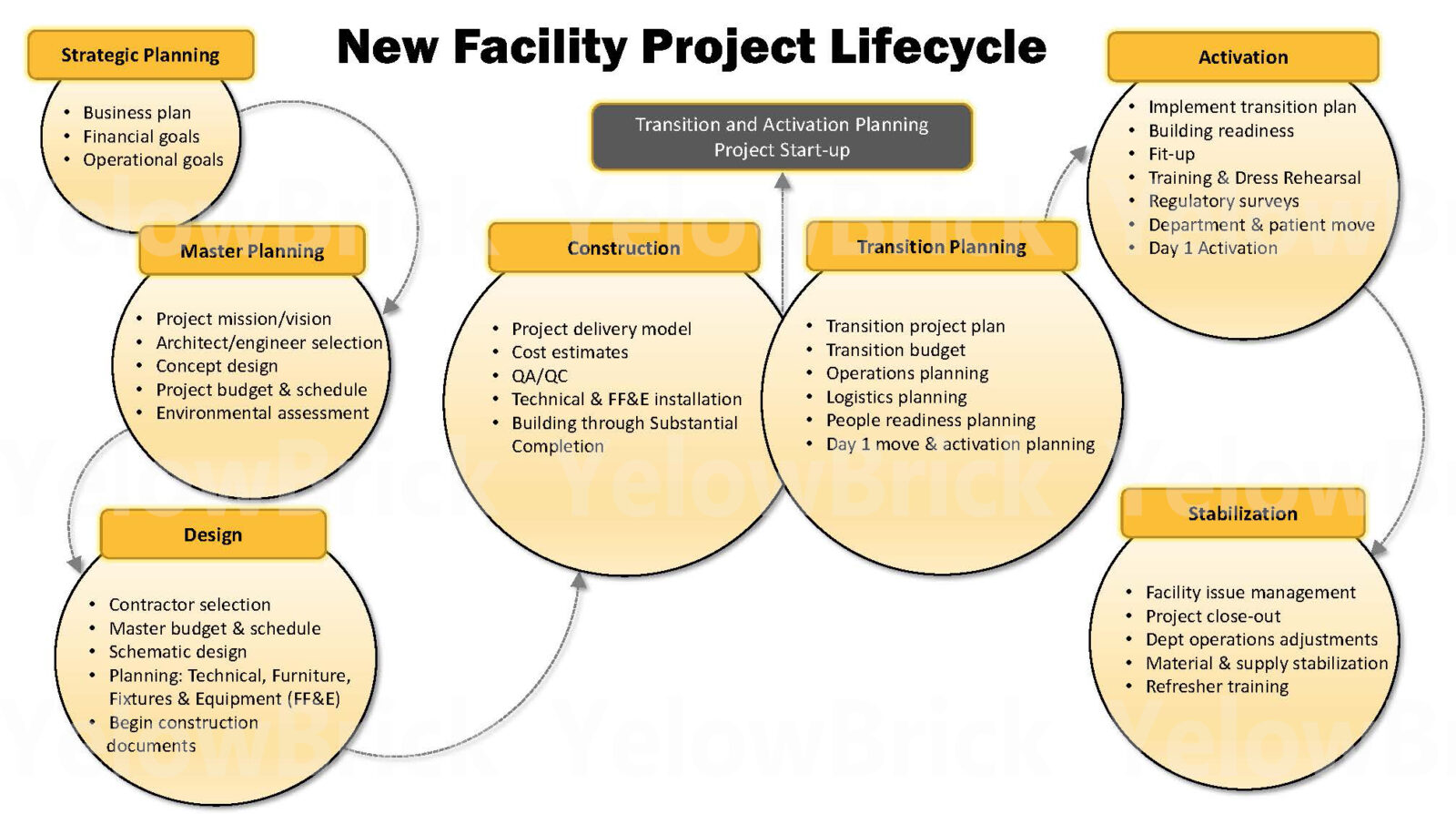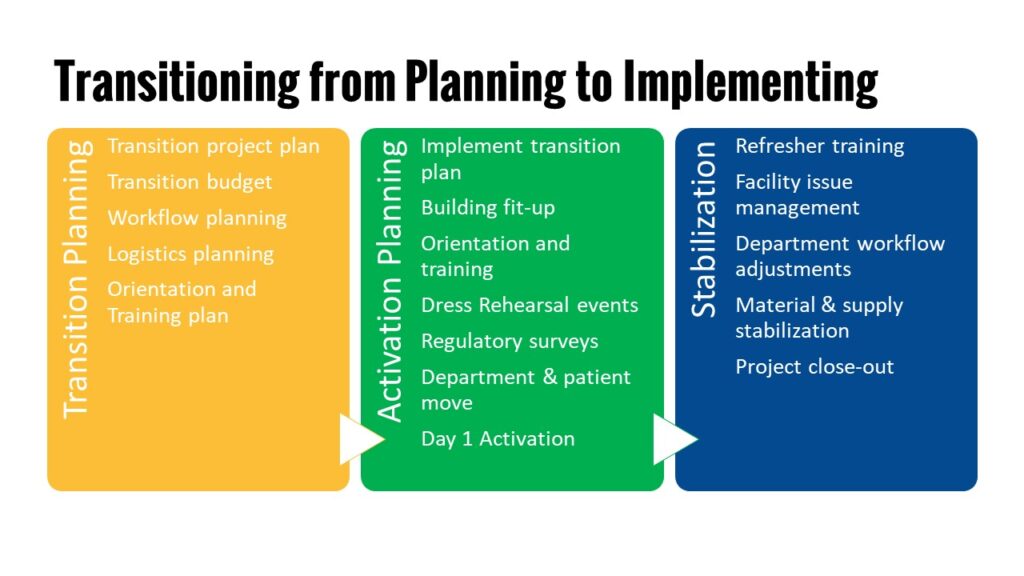By; Kathy Stevenson, BSN, RN, EDAC, LBBP, CMS
Understanding the continuum of a new healthcare facility project and its lifecycle is essential to defining the scope and resources required for a Transition and Activation Planning project. Decisions made during the Planning Phase can severely impact how staff and patients will function in the new space once it’s activated. When leading a transition and activation project, it is important to understand the various phases of a healthcare facility construction project and the work completed during each phase.

The Planning Phase: Strategic and Master Planning
This phase of the project usually occurs approximately 3-10 years before Day 1 Activation in the new facility. It includes the development of the strategic plan, master plan, environmental assessment, and business analysis. The planning phase focuses on identifying the needs and goals of the new facility project and the entities it will serve.
It is important to note that there is a significant gap in time between conceptualizing a new healthcare facility and the facility opening its doors to patients. During this time, patient population trends can change, which may cause the organization to reassess how the new facility will be utilized. So, if you are ever asked by a stakeholder during activation why space was designed like this, reference the Planning Phase’s original assumptions in order to provide the most transparent and meaningful answer.
The Design Phase
During this phase, the architects complete the schematic design concept and the design development documents. Negotiations occur to finalize space validation for program management and operational needs. The building is designed based on national and state guidelines, such as the Facility Guidelines Institute (FGI) https://fgiguidelines.org/, and project requirements that were developed during the Planning Phase. The Design Phase includes meetings with senior leadership and key stakeholders to ensure requirements are understood, prioritized, and delegated to the appropriate owners.
During this phase, the owner must make critical decisions that will drive the future of the new facility. Decisions and discussions include: How many beds should be on a unit? Which services should be adjacent to each other? And how many private vs. semi-private offices are needed in each unit or floor? This can be a stressful time for leaders because the turnaround time is often quite short. You will be reviewing the plans for every department and the process can be exhausting. It’s important to reference the project’s goals and vision in order to make decisions that support them.
The Construction Phase
During the Construction Phase, the facility engages a contractor and subcontractors who will build the new facility according to the architectural plans and requirements. At this time, the procurement process for equipment, furniture, and IT systems begins. This phase includes regular meetings with the owner, architect, and contractor (OAC) team and senior leadership to obtain updates to project estimates, including schedule, cost, and resources required.
Typically, this phase begins around 2-3 years prior to activation. Depending on the size of your project, it is our recommendation that you begin the assessment of whether your team will require the assistance of a Transition and Activation Planning consultant to guide your team through the process. In addition, the organization will need to identify an internal Transition and Activation lead and the team who will be responsible for ensuring that the organization is operationally ready to activate the new facility.

The Transition Planning Phase
This phase occurs in parallel with the construction of the new facility. It includes engaging stakeholders to plan and validate facility readiness, people readiness, and documentation readiness for the new facility. The Transition Planning Phase begins approximately two years before Day 1 Activation. Outputs of the Transition Planning Phase include facility resource identification, development of the Transition and Activation Budget, Transition and Activation Planning timeline and schedule, new operational plans and workflows, equipment and system procurement, orientation and training plan, fit-up plan, communication plan, regulatory plan, and move plan. This phase also involves regular meetings with the construction project team and leaders from within the organization.
In our experience, a major gap exists in the amount of time that organizations estimate that this planning process will take compared to the actual time required. Additionally, internal resources will be required to complete the planning work required.
The Activation Phase
During the Activation Phase, the focus changes from “planning” to “doing.” This phase begins six to eight months before the move and activation and is the time during which the building is transformed from a construction project to a living space. This phase actively engages end-users in the execution of the various plans developed during the Transition Planning Phase. There is a ramp-up period that involves thoughtful logistics planning to ensure that the appropriate people have access to the building at the right time and that the necessary resources are available to complete this work. This is the busiest time of the project for the owner and requires all hands on deck from the organization.
We recommend that organizations consider utilizing Dress Rehearsal events to validate the plans, systems, equipment, and space function as expected. These scripted, simulation exercises are not competency tests but instead focus on ensuring that Day 1 of Operations is not the end-users’ first time working in their new environment. These events often result in the identification of hundreds of issues that can then be prioritized and resolved prior to the first patient entering the space.
The Stabilization Phase
The Stabilization Phase includes the immediate post-activation activities. This phase can last anywhere from three to six months, and includes the following:
- Stabilizing ongoing operating procedures
- Conducting refresher orientation and training
- Facility issue management
Project closeout is conducted during this phase, which involves the facility transitioning from project to day-to-day operations. We recommend conducting a lessons learned session with the project team three to six months post-activation in order to review what went well, what could have been improved, and to document best practices the organization would like to incorporate in future projects.
Although each new healthcare facility project will be unique in nature, the phases described above will always occur. Having a solid understanding of the work accomplished in each phase will make you a stronger project manager and healthcare leader.

